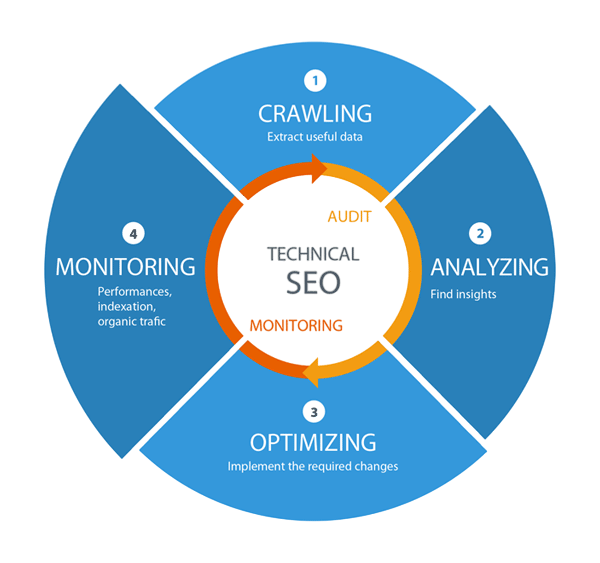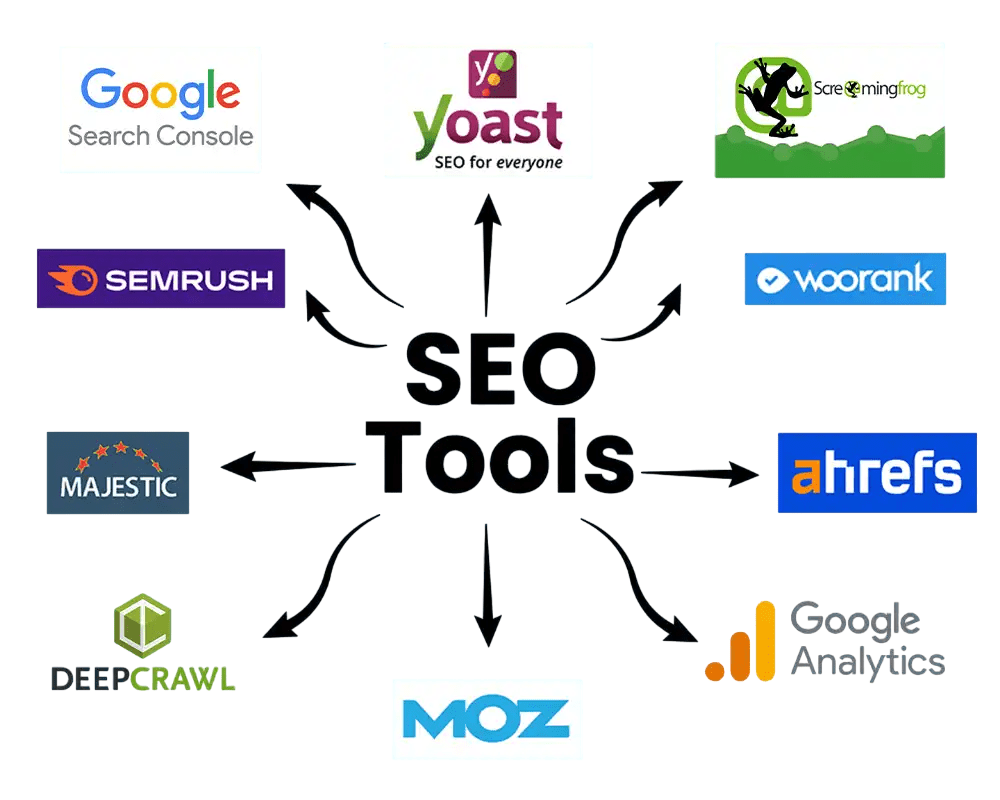
- Introduction to SEO
- Understanding Technical SEO
- Why Technical SEO is Important
- Key Elements of Technical SEO
- Tools to Analyze Technical SEO
- Common Technical SEO Issues and How to Fix Them
- How Technical SEO Impacts Overall SEO Strategy
- Best Practices for Technical SEO
- Conclusion
Introduction to SEO
Search Engine Optimization (SEO) is the art and science of enhancing your website so that it ranks better on search engines like Google, Bing, and Yahoo. The higher your website ranks, the more visibility it gains, which typically leads to more traffic and potential customers.SEO, Digital Marketing Training or Search Engine Optimization, is the practice of improving a website’s visibility in search engine results like Google. The goal of SEO is to increase organic (non-paid) traffic by making your site more relevant, trustworthy, and accessible to both users and search engines. At its core, SEO involves optimizing different parts of your website such as content, keywords, site structure, and technical elements so that search engines can better understand what your site offers. When done effectively, SEO helps your website rank higher for relevant search queries, Key Elements of Technical SEO, making it easier for your target audience to find you online. SEO is a long-term strategy that combines on-page SEO (like content and keywords), off-page SEO (like backlinks and social signals), and technical SEO (like site speed and mobile-friendliness). As search engines get smarter, successful SEO is no longer about just “tricking” the algorithm, it’s about providing real value to users. In today’s digital world, SEO is essential for businesses of all sizes that want to compete online, attract traffic, and grow their presence in a cost-effective and sustainable way. This blog focuses on the third aspect Technical SEO, which is often overlooked but crucial for a strong SEO foundation.
Ready to Get Certified in Digital Marketing? Explore the Program Now Digital Marketing Online Training Offered By ACTE Right Now!
Understanding Technical SEO
Technical SEO refers to the process of optimizing a website’s backend structure and foundation to improve its visibility and ranking on search engines. Unlike content optimization or link-building, technical SEO deals with site architecture, speed, mobile-friendliness, indexing, and other technical factors.Put simply, technical SEO makes sure search engines can effectively crawl, understand, and index your website. If your site isn’t technically sound, even the best content won’t perform well.Technical SEO Strategies refers to the behind-the-scenes elements of a website that help search engines crawl, index, and rank it effectively. While content and keywords help tell search engines what your site is about, technical SEO ensures your site can be properly discovered and understood. It’s the foundation that supports all other SEO efforts.

Key areas of technical SEO include website speed, mobile-friendliness, site architecture, URL structure, XML sitemaps, and robots.txt files. A well-structured site with clean code and fast load times provides a better user experience, which search engines reward with higher rankings. Other important technical aspects involve fixing broken links, avoiding duplicate content, using HTTPS security, and implementing structured data (schema markup) to help search engines better understand your content. Without strong technical SEO, even the best content may not rank well because search engines could struggle to access or index it. That’s why technical SEO is essential it ensures that your site is not only readable and usable for users but also optimized for search.
Why Technical SEO is Important
Imagine having a beautifully designed store with amazing products but no signage or roads leading to it. That’s your website without proper technical SEO, Crawlability hard to find and access.
Key reasons technical SEO matters:
- Improves Crawlability: Search engine bots can access and understand your pages.
- Enhances User Experience: Fast-loading, secure, Digital Marketing Components and mobile-friendly sites keep users engaged.
- Helps Indexing: Proper signals ensure your content is indexed correctly.
- Boosts Ranking: Google favors sites with clean, fast, and secure infrastructure.
- Avoids Penalties: Fixing duplicate content, broken links, and other errors prevents ranking drops.
In short, technical SEO is the backbone of your entire SEO strategy.
To Explore Digital Marketing in Depth, Check Out Our Comprehensive Digital Marketing Training To Gain Insights From Our Experts!
Key Elements of Technical SEO
- Website Speed & Performance: A fast-loading website improves user experience and is favored by search engines. Use tools like Google PageSpeed Insights or GTmetrix to monitor and improve load times.
- Mobile-Friendliness: Google uses mobile-first indexing, meaning it ranks sites based on how they perform on mobile devices. Your site must be responsive and easy to navigate on phones and tablets.
- Crawlability: Search engine bots must be able to access and crawl your site. Ensure your robots.txt file is correctly configured and not accidentally blocking important pages.
- Indexability: Once crawled, your content must be indexed to appear in search results Digital Marketing Training . Use meta tags like no index and sitemaps wisely to guide what should or shouldn’t be indexed.
- XML Sitemap: An XML sitemap helps search engines understand your site structure and find all important pages. Submit it to Google Search Console and keep it updated.
- HTTPS Security: Secure websites (using HTTPS) are preferred by search engines. It builds user trust and is a confirmed Google ranking factor.
- Structured Data (Schema Markup): Adding schema helps search engines better understand your content and display rich results (like reviews, FAQs, or event info) in search listings.
- Fixing Errors (404s, Redirects, Broken Links): Regularly audit your site for broken links, missing pages, or improper redirects. These issues hurt SEO and frustrate users.
- Canonicalization: Use canonical tags to prevent duplicate content issues by telling search engines which version of a page is the original or preferred one.
Tools to Analyze Technical SEO
Types of Social Media Several tools help diagnose and improve your technical SEO:
- Google Search Console: Crawl errors, indexing status, mobile usability.
- Google PageSpeed Insights: Site speed and performance.
- Screaming Frog SEO Spider: Crawl and audit site structure.
- Ahrefs / SEMrush: Comprehensive SEO audits including technical issues.
- GTmetrix: Site speed and optimization suggestions.
- Mobile-Friendly Test: Checks mobile usability.

Looking to Master Digital Marketing? Discover the Digital Marketing Expert Masters Program Training Course Available at ACTE Now!
Common Technical SEO Issues and How to Fix Them
| Issue | Description | How to Fix |
|---|---|---|
| Slow page speed | Pages take too long to load | Optimize images, reduce code, use CDN |
| Duplicate content | Same content on multiple URLs | Use canonical tags, no index duplicates |
| Broken links (404 errors) | Links lead to non-existent pages | Redirect or fix broken URLs |
| Poor mobile usability | Site not optimized for mobile | Use responsive design, test usability |
| Incorrect robots.txt settings | Blocking important pages | Audit and update robots.txt |
| Missing or incorrect sitemap | Search engines miss important pages | Generate and submit updated sitemap |
| Lack of HTTPS | Site is not secure | Install SSL certificate |
How Technical SEO Impacts Overall SEO Strategy
Digital Marketing Case Studies Without a solid technical SEO foundation:
- Your content and backlinks might go unnoticed.
- You risk losing traffic due to poor user experience.
- Your site could be penalized for errors or security issues.
- Search engines can easily crawl and index your site.
- Your site loads fast and looks good on any device.
- Users enjoy a seamless experience, boosting engagement.
Conversely, with strong technical SEO:
Thus, technical SEO is the essential backbone supporting your on-page and off-page efforts.
Best Practices for Technical SEO
Implementing technical SEO best practices ensures that your website is accessible, efficient, and optimized for both users and search engines. Start by improving your site’s loading speed, as faster websites not only provide a better user experience but also rank higher in search results. Make sure your website is fully mobile-friendly, Social Media Marketing Salary. since Google prioritizes mobile-first indexing. Use a clear and logical site structure with internal linking to help both users and search engines navigate your content easily. Regularly update and submit an XML sitemap and check your robots.txt file to ensure important pages are crawlable. Secure your website with HTTPS to build trust and improve your ranking potential. Avoid duplicate content by using canonical tags and managing URL parameters properly. It’s also important to fix technical issues like broken links, redirect errors, Technical SEO Issues and slow-loading pages through regular site audits. Lastly, use structured data (schema markup) to help search engines better understand your content and improve your visibility in the form of rich snippets. Following these best practices lays the groundwork for a healthy, high-performing website that supports long-term SEO success.
Preparing for Digital Marketing Job Interviews? Have a Look at Our Blog on Digital Marketing Interview Questions and Answers To Ace Your Interview!
Conclusion
Technical SEO might seem complex, but it’s the foundation of every successful SEO campaign. From ensuring fast loading speeds and mobile usability to creating a secure, Digital Marketing Training ,crawlable website, backlinks , Crawlability the technical side ensures your content has the best chance to rank. If you want your website to perform well on search engines, mastering technical SEO is non-negotiable. It complements your content and link-building efforts by ensuring your site’s infrastructure is optimized for both users and search engines.




